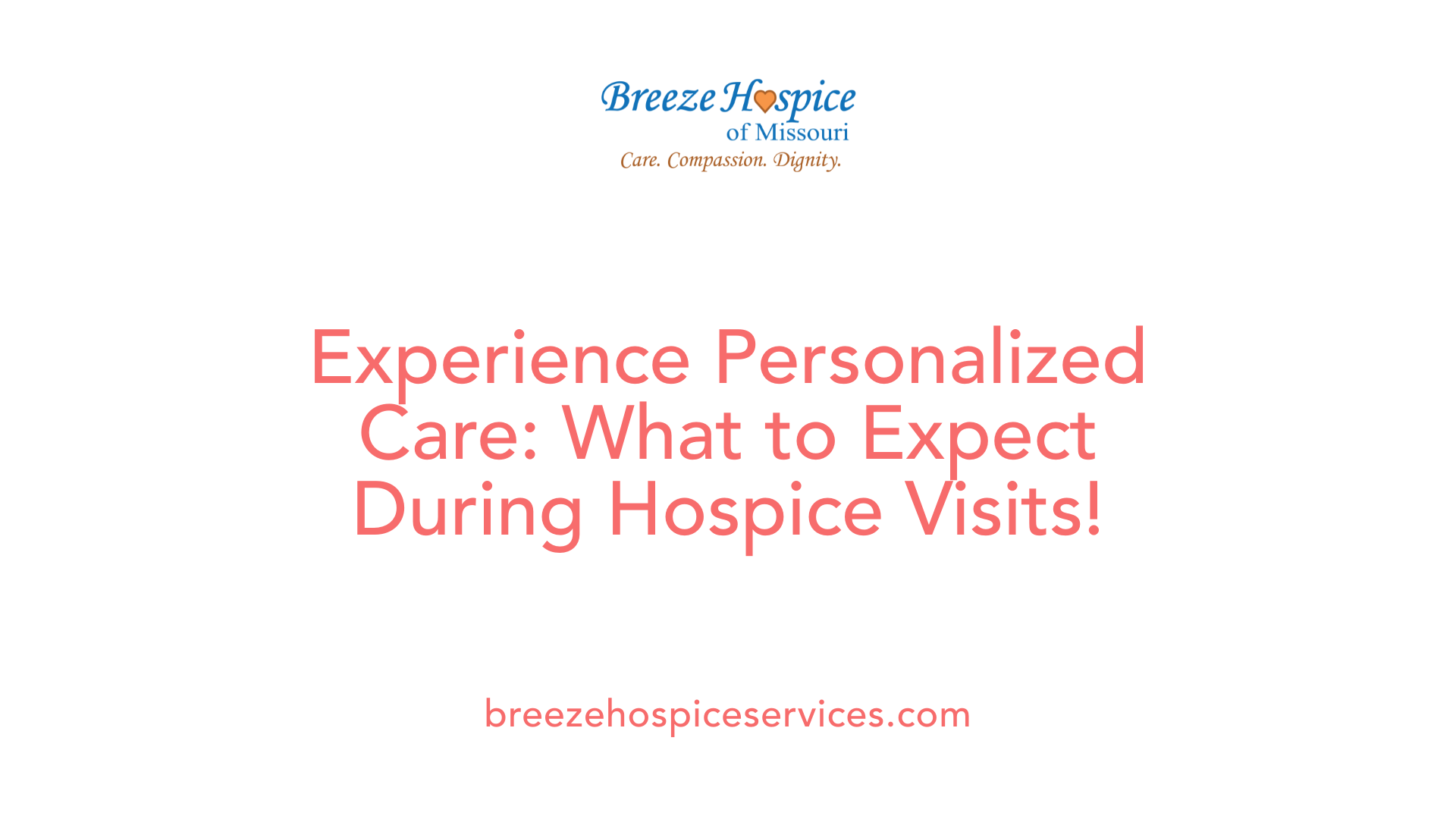What to Expect During In-Home Hospice Visits
April 8, 2025
Understanding the Dynamics of At-Home Hospice Services

Introduction to In-Home Hospice Care
In-home hospice care is a compassionate choice for individuals approaching the end of life, prioritizing comfort and quality in a familiar setting. This form of care involves the coordination of various healthcare professionals providing comprehensive and personalized support to both the patient and their family. Understanding what happens during in-home hospice visits is crucial for families making this transition, as it eases their responsibilities and enhances the patient's comfort.
Arranging In-Home Hospice Care

How can I arrange hospice care at home?
To begin the process of arranging hospice care at home, you can either request a referral from your treating physician or initiate a self-referral by contacting a hospice provider directly. This flexible approach allows you to seek the care that aligns with your needs and preferences.
What are the eligibility criteria for hospice care?
Typically, the eligibility criteria for hospice care include a terminal diagnosis with a life expectancy of six months or less. This prognosis must be confirmed by the patient's physician, facilitating specialized care tailored to the patient’s unique situation. A key aspect of this process includes the patient or their authorized representative providing consent to proceed with hospice services after an assessment.
How does the consent process work?
The consent process involves discussions between the hospice team and the family regarding the patient's prognosis and care options. It’s essential to ensure that all parties are informed and agree on the path forward, emphasizing comfort care rather than curative treatments.
Is hospice care covered by insurance?
Medicare and Medicaid generally cover hospice services, which may include home health aides, medications, and needed medical equipment. However, it's important to review specific eligibility details and coverage limitations depending on your insurance plan, ensuring that you understand what services will be provided under hospice care.
Initiating In-Home Hospice Care

What happens when someone is sent home on hospice care?
When someone is sent home on hospice care, they transition to receiving support from a specialized team of healthcare professionals. This team typically includes:
- Physician – oversees medical care and creates treatment plans.
- Registered Nurse (RN) – visits regularly to monitor the patient’s health, manage symptoms, and educate family members.
- Social Worker – assists with emotional and practical aspects of care, providing counseling and resources.
- Chaplain or Spiritual Counselor – addresses spiritual needs and offers support in alignment with personal beliefs.
- Hospice Aide – helps with personal care and daily living activities.
- Volunteers – provide companionship and assist with light tasks to alleviate the caregiver’s burden.
Within the first week, patients typically experience an initial series of visits as the team assesses their condition and develops a personalized care plan. This plan focuses on addressing immediate needs, including pain management and emotional support.
During these visits, essential medical equipment and medications are delivered to the home within the first 24 hours, ensuring that all necessary supplies are in place to foster a comfortable environment. The team maintains communication with the patient’s physician to continually adapt the care plan based on the patient’s evolving condition, while family members play an integral role in decision-making and care responsibilities.
Understanding the Routine of In-Home Hospice Visits

What should I expect during hospice care at home?
During hospice care at home, you can expect a supportive team dedicated to helping your loved one during their final stages of life. This team typically includes a physician, nurse, hospice aide, social worker, chaplain, and volunteers. They work together to create a personalized care plan that addresses medical, emotional, and spiritual needs.
The first few days usually involve frequent visits from the hospice team to assess needs and deliver necessary medical supplies and equipment. However, as the days progress, a routine schedule develops, which is agreed upon with the family to suit their needs. These visits might consist of nurses checking vital signs, hospice aides assisting with personal care, and social workers providing emotional support.
How do family caregivers fit into hospice care?
Family members are encouraged to take on the primary caregiver role, with the hospice team providing guidance and support. This approach allows families to be actively involved while receiving training on how to manage care responsibilities effectively. The collaboration not only ensures that the patient's needs are met but also alleviates some of the stress on family caregivers.
What type of interactions can I expect from the hospice team?
Team interactions are frequent and structured. The hospice team will communicate regularly about the patient's condition and any adjustments needed in the care plan. Weekly meetings are held to review and revise care strategies based on the patient's changing needs. During these interactions, team members introduce themselves and explain their roles, ensuring the family understands the support available.
How is emotional and spiritual support provided?
Emotional and spiritual support are essential components of hospice care. Chaplains and social workers conduct emotional assessments to address concerns related to grief and anxiety, aligning care with the patient's beliefs and values. This ensures that both the patient and family receive comprehensive support throughout the end-of-life journey, fostering a peaceful and dignified environment.
Costs and Financial Considerations of Hospice at Home

What are the costs associated with hospice care at home?
The costs associated with hospice care at home can vary based on the patient's insurance coverage and the level of care required.
- Routine Home Hospice Care: Typically covered by Medicare, this type of care costs approximately $211.34 per day for the first 60 days and $167 for subsequent days.
- Continuous Home Hospice Care: This option, which provides 24/7 support, is significantly more expensive, averaging around $1,522.04 per day.
Most patients with insurance enjoy minimal out-of-pocket expenses for hospice services. However, individuals who are uninsured may face substantial costs unless the provider offers a reduced rate. Thus, depending on the individual circumstances, out-of-pocket expenses can range from virtually nothing to significant amounts for those without coverage.
Who is responsible for paying for hospice care at home?
Typically, the financial responsibility for hospice care at home falls to the patient, who uses the Medicare Hospice Benefit. This benefit covers up to 100% of the services related to terminal illness, including medical equipment, medications, and clinical visits. It's essential to note that curative treatments and costs associated with room and board are not covered.
For those not eligible for Medicare, options include private insurance, self-payment, or assistance from charitable organizations. Additionally, Veterans' Administration benefits and various state Medicaid plans may also contribute toward hospice care costs, making it crucial for families to understand their coverage.
Variability of Costs
Overall, costs can differ greatly based on the individual's insurance status and the specifics of the care required. For more detailed guidance on financial planning for at-home hospice care, consulting with a financial advisor or hospice representative can provide tailored insights.
Debunking Myths and Setting Expectations

What common misconceptions exist about hospice care?
Hospice care is often surrounded by many myths that can create confusion for families. A prevalent misconception is that hospice provides around-the-clock care at home, which is not the case. Typically, families assume that they will receive continuous assistance, but in reality, hospice teams usually visit a few times a week, with family caregivers being responsible for much of the daily care between visits.
What responsibilities do families have during hospice care?
Families should prepare for significant responsibilities, including managing medications and providing personal care for their loved ones. Hospice teams indeed offer support, but the primary role of hands-on care generally falls on family members. Hence, understanding this dynamic is crucial to avoid overwhelming feelings.
What might hospice not disclose to families?
Hospice may not disclose to families the full extent of caregiving responsibilities they will need to shoulder. Families often might not be aware of the complexities around eligibility for hospice services, particularly for patients facing conditions like dementia. Financial implications can arise, as medications and equipment costs might not be fully covered by insurance. Moreover, families may misconceive that entering hospice leads to an immediate decline in health, as eligibility is based on prognosis rather than a defined timeline for death.
Embracing the Benefits of In-Home Hospice Care
In-home hospice care provides a loving and supportive environment for patients during their final journey, allowing them to spend precious time in familiar surroundings with their family. Understanding the ins and outs of hospice visits ensures that loved ones can adequately prepare and embrace the full benefits of this invaluable service, setting the stage for a peaceful and dignified end-of-life experience. The reassurance of having expert care available, while maintaining control over the home environment, makes this option both widely appealing and comforting.
References
- What to Expect When Starting Hospice at Home - VITAS Healthcare
- Starting hospice: What to expect
- What to Expect from Hospice Care at Home - VITAS Healthcare
- 5 Things to Expect When Going Home for Hospice
- What Does In-Home Hospice Care Provide?
- Hospice Care at Home – What You Should Expect
- Hospice at Home: What to Expect | WesleyLife Foundation
- About Hospice - Florida Hospice & Palliative Care Association


































































































